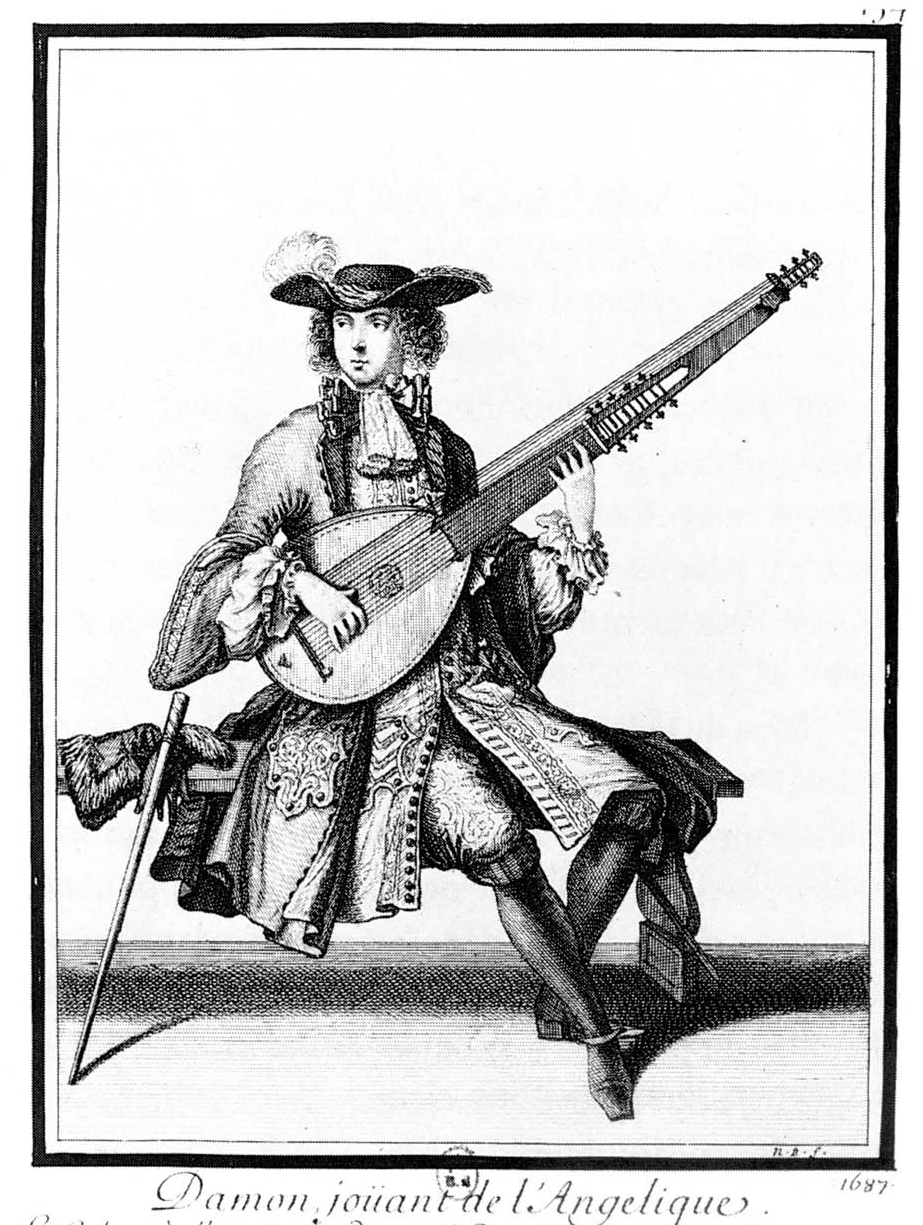- Angélique (instrument)
Infobox Instrument
name=Angélique
names=
classification=
*Necked bowl lutes
*String instruments
range=
related=
*Angélique (instrument)
*Archlute
*Balalaika
*Barbat (lute)
*Bağlama
*Biwa
*Bouzouki
*Charango
*Chitarra Italiana
*Daguangxian
*Đàn tỳ bà
*Dombra
*Domra
*Dutar
*Electric pipa
*Erhu
*Irish bouzouki
*Liuqin
*Lute
*Mandocello
*Mandola
*Mandolin
*Oud
*Pandura
*Pipa
*Rubab
*Setar
*Sitar
*Surbahar
*Tanbur
*Tanbur (Turkish)
*Tembûr
*Theorbo
*Tiorbino
*Tiqin
*Topshur
*Veena
*Zhonghu The angélique (French, from Italian angelica) is a plucked string instrument of the
lute family of the baroque era. It combines features of thelute , theharp and thetheorbo .It shares the form of its pear shaped body as well as its vibrating string length of 54 to 70 cm with the lute. Differing from the lute, the 15-17 string angelica was single-strung like a
theorbo , with which it shares its extended neck with a second peg box, bearing eight to ten bass strings.The angelica was tuned diatonically, like a harp: C – D – E – F – G – A – B – c – d – e – f – g – a – b – c’ – d’ – e’. That range is the same as that of the French or lesser theorbo, but the latter differs in that its tuning is reentrant: C – D – E – F – G – A – B – c – d – g – c' – e'– a – d'. The diatonic tuning limited its compass, but produced a full and clear tone by the increased use of open strings. There were also some partially diatonic tunings like A - B - C – D – E – F – G – A – B – c – d – f – a– d – f'.
Little surviving music for the angelica as well as few surviving instruments indicate that the angelica flourished during the second half of the 17th and the beginning of the 18th centuries. It is first mentioned by
Praetorius (Theatrum instrumentorum, pl.xxxvi), who said it was played like a harp, although the extant music for the instrument shows no such characteristic.Some authors claim that the angelica was invented in England. But that claim is based on the misinterpretation of its name (M. H. Fuhrmann, Musicalischer Trichter, Frankfurt/Spree 1706, p. 91). James Talbot correctly interpreted angelica as “angel lute“ because of its lovely sound (ms. Oxford 532, 1685–1701).
Music for the angelica is notated in French tablature, with the designation of bass courses varying according to respective authors.
Ukrainian
Torban is a descendant of Angélique.Bibliography
*Praetorius, "Theatrum instrumentorum"
*L. Brugmans, "Le séjour de Christian Huygens à Paris" (Paris,1935), 151
*F. Lesure: ‘The angélique in 1653’, "GSJ", vi (1953), 111–12
*F. Lesure: ‘Les luthistes parisiens à l’époque de Louis XIII’, "Le luth et sa musique" (Neuilly-sur-Seine, 1957), 222–3
*M. Prynne: ‘James Talbot’s Manuscript: IV: Plucked Strings – the Lute Family’, "GSJ", xiv (1961), 52–68
*E. Pohlmann, "Laute, Theorbe, Chitarrone: die Instrumente, ihre Musik und Literatur von 1500 bis zur Gegenwart" (Bremen, 1968, 5/1982), 394–7
*E. Vogl: ‘Die Angelika und ihre Musik’, "HV", xi (1974), 356–71
*G. Hellwig, "Joachim Tielke: ein Hamburger Lauten- und Violenmacher der Barockzeit" (Frankfurt, 1980), 304–5
*C. Meyer and M. Rollin, "Oeuvres de Gumprecht" (Paris, 1993), xviiources
*Jakob Kremberg, "Musicalische Gemüths-Ergoetzung oder Arien ..." (Dresden: 1689), in Tabulature
*Adalbert Quadt (Hg.), "Gitarrenmusik des 16-18. Jahrhunderts 2, nach Tabulaturen für Colascione, Mandora und Angelica", (Leipzig: 1971)
*Hans Radtke (Hg.), "Ausgewählte Stücke aus einer Angelica- und Gitarrentabulatur, Musik Alter Meister Heft 17", (Graz: 1967)ee also
*
Lute
*Tablature
*Baroque Music
Wikimedia Foundation. 2010.
